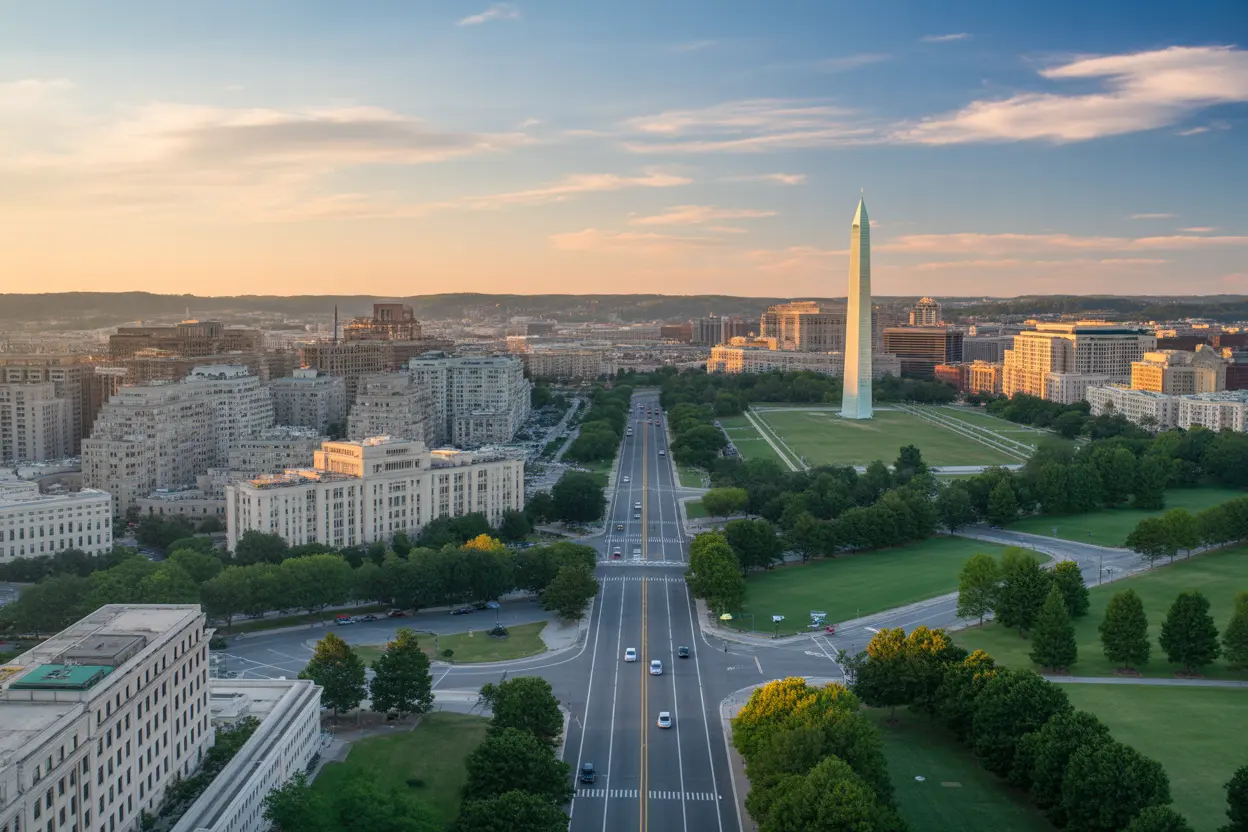The Real Cost of Living in Washington, DC (And What It Means for Your Move)

When people consider relocating to Washington, DC, the first question that often arises is: Is it expensive to live in Washington? The answer, like many things in life, depends on your lifestyle, income, and expectations. However, there’s no denying that the cost of living in Washington, DC is well above the national average. Understanding what this means for your bottom line is crucial—especially if you’re planning a move to the nation’s capital in 2025.
In this comprehensive guide, we’ll break down the key components of the Washington, DC cost of living index, provide detailed price comparisons, and help you understand how your move will impact your financial planning.
What the Washington, DC Cost of Living Index Tells Us
The Washington, DC cost of living index is a numerical value that compares the cost of goods and services in DC to the national average, which is set at 100. As of 2025, the city’s cost of living index sits around 154, meaning it’s about 54% higher than the U.S. average. This reflects higher expenses in almost every category—from housing to transportation and beyond.
Cost of Living Washington, DC: Major Components
To understand the full picture, let’s look at the key factors contributing to the cost of living in Washington, DC:
- Housing: DC boasts median home prices over $700,000 and average monthly rents for one-bedroom apartments hovering around $2,500. High demand and limited supply make real estate particularly competitive. Luxury apartments and condos in neighborhoods like Georgetown or Capitol Hill often command even higher prices, while outer neighborhoods offer some relief for budget-conscious renters.
- Transportation: Public transit is widely used, but costs can add up quickly if you drive due to parking fees and insurance premiums. Metro fares can range between $2–$6 per trip depending on time and distance, and monthly unlimited passes cost about $64–$100. If you rely on a car, expect to pay at least $200 a month for parking in many areas, plus higher-than-average auto insurance premiums due to urban density.
- Utilities: Monthly utilities cost an average of $150–$200, depending on apartment size and usage. This includes electricity, water, gas, trash, and internet. During winter months, heating costs can push utility bills even higher, especially in older properties.
- Groceries: Expect to spend about 10–15% more on food and household goods than you would in other U.S. cities. Shopping at national chains like Safeway and Trader Joe’s may help manage costs, while shopping at local co-ops or farmers’ markets can add variety but may come with higher prices, especially for organic produce.
- Healthcare: Health insurance and medical visits are more expensive than the national average. Premiums for private health plans can exceed $400 per month for individuals and more for families. Out-of-pocket expenses such as specialist visits, prescriptions, and emergency care also contribute to the higher healthcare burden.
Is It Expensive to Live in Washington?
The short answer is: yes. But let’s expand that into a more meaningful evaluation. Living in DC means gaining access to well-paying jobs, diverse communities, and unparalleled cultural institutions—but it comes with significant costs. Rent prices are among the highest in the country, and even daily living—like going out to eat or paying for daycare—can drain your wallet if you’re not prepared.
Dining out at mid-range restaurants might cost $20–$40 per person, and even casual cafes or fast food spots can add up quickly when part of a regular routine. Personal services like gyms, salons, and dry cleaners may also carry a premium. For example, gym memberships average $60–$90/month depending on amenities and location.
Comparing DC to Nearby Cities
Let’s take a quick look at how Washington, DC compares to neighboring areas in terms of living costs:
- Washington, DC: High costs in every category, especially housing.
- Arlington, VA: Also expensive, but often offers more modern housing for similar prices. Many families and professionals opt for Arlington due to access to quality schools and slightly more space.
- Baltimore, MD: Roughly 30% cheaper overall than DC, especially regarding rent and food. However, this affordability may come with trade-offs in commute times and access to professional opportunities found in the capital.
While the cost of living in Washington, DC is steep, many residents consider it worth the price due to the high quality of life, excellent schools, and rich job market. DC is home to some of the top public and charter schools in the region, and its job market remains strong, especially in government, nonprofit, and tech sectors.
How Much Do You Need to Live Comfortably in Washington, DC?
To live comfortably in Washington, DC in 2025, a single adult should aim for an income of at least $90,000 annually. For a family of four, that number jumps significantly—closer to $200,000, depending on personal preferences and financial responsibilities. This estimate includes basic necessities, savings goals, and room for recreational activities.
Here’s a sample monthly budget for a single professional in DC:
- Rent (1-bedroom apartment in city center): $2,500
- Utilities: $200
- Groceries and dining: $700
- Transportation: $150
- Healthcare: $400
- Entertainment and personal care: $300
- Total: $4,250/month or $51,000/year (excluding income taxes)
This estimate does not include debt repayment, student loans, or contributions to retirement beyond basic savings, making actual financial needs potentially even higher for many individuals.
The Cost of Moving to DC
In addition to the living expenses, don’t forget that relocating to DC also involves upfront moving costs. If you’re bringing furniture, hiring professionals like a trusted Washington, DC moving company is essential. Depending on your situation, moving services can range from $1,500 to $5,000 or more.
Movers typically charge based on distance, volume of belongings, and required labor. If you’re relocating from out of state, cross-country moves can reach upwards of $7,000, especially if additional services like packing, temporary storage, or assembly/disassembly of furniture are involved.
Hidden Costs to Consider:
- Security deposits and first/last month’s rent
- New furniture or home goods
- Utility setup fees
- Transit passes and parking permits
- Childcare or temporary accommodations during the move
Strategies to Manage High Living Costs
- Consider a roommate: Sharing rent can cut your housing budget in half.
- Live near transit: Choose neighborhoods close to Metro stations to save on transportation.
- Brown bag your lunch: Dining out in DC is pricey. Preparing meals can cut food spending by 40%.
- Utilize free attractions: DC is rich with free museums, galleries, and events that provide entertainment without added expense.
- Lower utility costs: Use energy-efficient appliances and monitor usage to keep bills in check.
Additionally, take advantage of community resources. DC libraries offer free internet and events, and neighborhood listservs like Nextdoor or Facebook Buy Nothing groups can help you furnish your home on a budget.
Best Neighborhoods for Price-Conscious Movers
Some neighborhoods offer better value when balancing cost, location, and quality of life. Consider:
- Brookland: Great for families and students, offering relative affordability and strong community vibes.
- Petworth: Popular among young professionals; rent is lower, but it’s still Metro-accessible.
- Trinidad: An up-and-coming spot with lower home prices and close proximity to Capitol Hill.
Other notable options include Columbia Heights and Deanwood. While still located within DC, they provide slightly more affordable rent with access to public transportation, local businesses, and parks. Be sure to visit neighborhoods at different times of day to get a full sense of their vibe and safety.
Making the Move: Final Considerations
If you’ve decided DC is the place for you, plan your move with care. From budgeting based on the Washington, DC cost of living index to choosing the right moving support, preparation is key. Use resources like a reputable Washington, DC moving company to streamline your transition.
Also, explore job opportunities in advance. Many employers in DC offer higher salaries to offset the higher cost of living, particularly in industries like government, law, education, and technology. Tap into local networking events, career fairs, and platforms like LinkedIn and Handshake to connect with recruiters and hiring managers before relocating.
Conclusion
So, is it expensive to live in Washington? Absolutely. The city is one of the most expensive in the country, but it offers unparalleled opportunities, cultural experiences, and career options that many find well worth the premium. The cost of living in Washington, DC should be a factor you carefully consider—balance your income, savings goals, and lifestyle preferences when making a move.
Understanding the cost of living in Washington, DC landscape will put you in a better position to make informed decisions for your future. With planning and the right resources, including help from a professional Washington, DC moving company, your move to the capital can be a smart and successful investment in your future.

